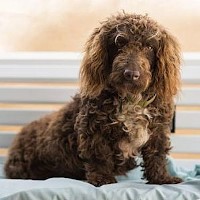Appearance of the Bassetoodle
|
| Bassetoodles will take on the traits of both parent breeds, and will vary in size according to the size of Poodle used in the breeding process. The most common look for a Bassetoodle is small and low to the ground, with the body of a Basset Hound combined with the fur and facial features of a Poodle. The medium-length coat comes in a variety of colors and is generally thick and wiry, with a straight or wavy appearance. This type of coat is ideal for allergy sufferers, as it is completely hypoallergenic. This breed's ears are considerably shorter than a Basset Hound's, framing a short but cute muzzle. The nose is generally black or dark brown, depending on the coat color. Finally, the Bassetoodle's eyes are always bright and full of life, seemingly full of endless mischief lurking just behind the dark brown color. |
Temperament of the Bassetoodle
|
| If you're looking for an active but friendly dog that works well in any housing situation, then your search is over. The Bassetoodle has a jovial, mischievous personality which, when properly entertained and exercised, makes it an excellent active companion. Although this breed has the calm demeanor of the Basset Hound, both parent breeds are working dogs that love to get out and have a good run, whether after prey or their favorite ball. This means that you can't count on your dog running smoothly without too much exercise. He'll need to get out and play to curb any destructive tendencies that may arise when he gets bored. All in all, when it comes to the Bassetoodle, the best of both parent breeds has been combined very well. Slightly protective of his family, without being aggressive, this breed has a tendency to howl at anything he may find suspicious, so if this doesn't bother you, it shouldn't be a problem. Good socialization while young will ensure that your Bassetoodle does as well as it's supposed to with young children and other animals. This breed makes an excellent pet, however, bear in mind that the Bassetoodle has a very low tolerance for being left alone, so be prepared for separation anxiety if you have to leave your dog for long periods. |
Needs and activities of the Bassetoodle
|
| One of the most important things to know about the Bassetoodle is that it tends to be a wanderer. When carrying out any type of exercise, always make sure you use a leash or are in an enclosed area; if you're not careful, your dog may go off on an adventure without you. On top of that, the cold is something this breed doesn't particularly like. If you need to exercise your dog during the cold winter months, doggy daycare or a short walk in the yard can do the trick. The Bassetoodle is a moderately energetic dog that requires at least one walk a day and good quality outdoor playtime. Activities such as retrieving, training, jogging or a long walk are perfect to help burn off the extra energy your dog has stored up. Although this breed makes an excellent pet, remember that if he doesn't get the chance to exercise, he can become destructive and ruin some of your favorite possessions. However, that aside, if your Bassetoodle can get quality exercise and lots of good training, you shouldn't have any problems at all with him maintaining a calm disposition. |
Maintenance of the Bassetoodle
|
| The Bassetoodle is a relatively low-maintenance type of dog. Its medium-long, stiff coat will shed a moderate amount throughout the year. Frequent brushing, perhaps 2-3 times a week, is the best way to limit shedding, and can be done with a toothed comb. Bathing should only be done occasionally or when your Bassetoodle is particularly dirty. Always be sure to dry your dog's ears thoroughly to remove any excess moisture. Because the Bassetoodle has folded over the ears, any traces of moisture or foreign bodies can cause infection or irritation. Frequent cleaning and thorough drying of the ears should reduce the risk of ear problems. In addition to brushing and bathing, dental care and nail trimming should be part of the routine. Nails can be trimmed every few weeks or so, so if you hear your dog clicking on the floor, it's time to trim. |









 English (United Kingdom)
English (United Kingdom)